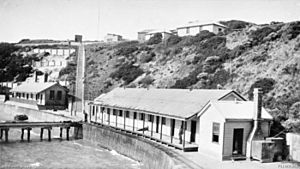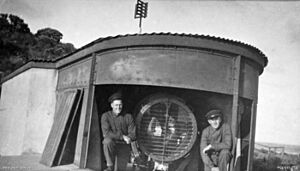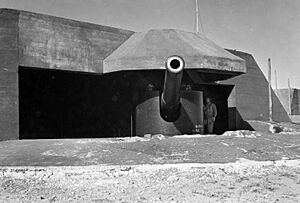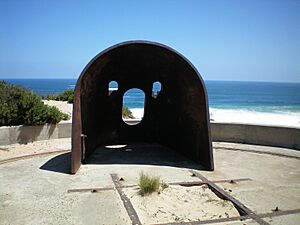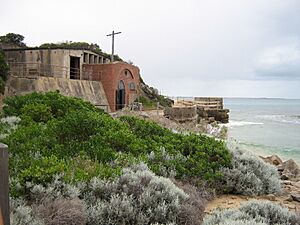Fort Nepean facts for kids
Fort Nepean is an old fort that helped protect Point Nepean, Victoria, Australia. It was part of a group of forts that guarded the narrow entrance to Port Phillip Bay. These forts were controlled from Fort Queenscliff. Today, Fort Nepean is part of Point Nepean National Park and a popular place for tourists to visit.
Contents
Why Fort Nepean Was Built
After a big study in 1875–76 about Victoria's volunteer soldiers, the government asked an expert from London, Lieutenant General Sir William Jervois, for advice. He came to Victoria in 1873. He suggested that the best way to protect the area was to build strong forts at the entrance to the bay. This is why Fort Nepean was created.
Forts and Cannons
Work on the forts and army buildings at Point Nepean started in 1873. Big cannons were put in place by 1886. By the 1890s, Fort Nepean was so strong it was called "Victoria's Gibraltar". Soldiers from the Royal Victoria Volunteer Artillery Regiment lived in the barracks.
Early Cannons (1878–1880)
The first cannons used for coastal defense were four 80-pounder guns. These were first placed in temporary sandbag areas. Later, they were moved into stronger earth emplacements starting in 1880.
More Powerful Cannons (1886–1890)
Between 1886 and 1890, ten places for cannons were built. Not all of them got guns right away. By 1890, the fort had four 6-inch "disappearing guns." These guns could pop up to fire and then hide again. There were also two very large 9.2-inch guns and a smaller 4.7-inch quick-firing gun. One old 80-pounder gun spot was used as a lookout.
Some of these powerful 9.2-inch guns were also installed at Fort Queenscliff. Other similar guns were placed in Sydney at Ben Buckler Gun Battery, Signal Hill Battery, and Steel Point Battery.
Changes Before World War I (1907–1915)
From 1911, the fort was managed by the Royal Australian Garrison Artillery. As war in Europe seemed likely, newer, longer-range 6-inch Mk VII guns replaced the 9.2-inch guns. One of the 6-inch guns was removed. The 4.7-inch gun was also taken out, and its spot was used for a searchlight. An engine house was built to make electricity for the searchlight.
World War II Changes (1939–1942)
In 1939, light anti-aircraft guns were brought to the fort. The remaining old 6-inch guns were removed in 1940. The main gun emplacements were updated and given concrete covers for better protection.
Fort Nepean in the World Wars
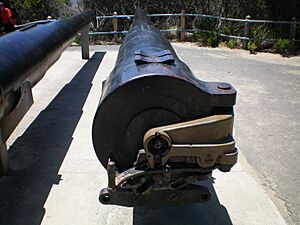
Fort Nepean is famous because it fired the first Australian shots of both World War I and World War II. Many people even say these were the first Allied shots of both wars.
On August 5, 1914, a German ship called the SS Pfalz tried to leave Port Phillip. War had just been declared. Lieutenant-Colonel Sandford at Fort Queenscliff ordered Lieutenant C Morris at Fort Nepean to "stop her or sink her." The Pfalz did not stop when signaled. So, a 6-inch gun fired a warning shot across its front. The Pfalz then turned around, and its crew was arrested at Portsea.
Later, at 1:30 AM on September 4, 1939, just hours after World War II began, another gun fired. This time, it was a warning shot across the front of a ship that did not identify itself. The ship then said it was the Australian freighter SS Woniora.
These were the only times the guns at Port Phillip fired in anger.
After World War II
After World War II, coastal forts were no longer needed as much. The guns were taken apart and sold for scrap metal. However, the barrels of the historic Mk VII guns that fired in the wars were saved. They were found in the 1960s and brought back to the fort.
Becoming a National Park
The Fort Nepean area was opened to the public in 1988. This happened when the Point Nepean National Park was created. Now, visitors can explore the old fort and learn about its important history.


